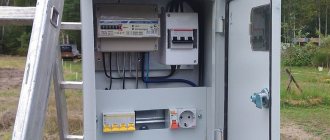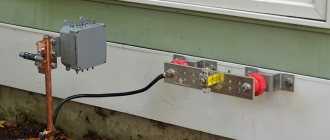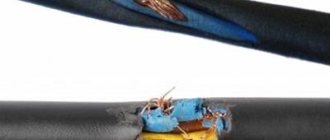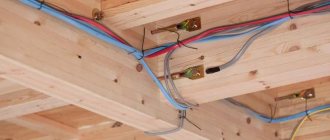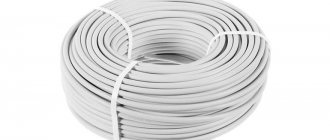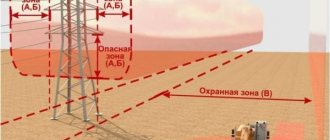Connection of 15 kW to a private house. Connection diagram
If you are the owner of a dacha or a country house (or perhaps you are going to join the audience of developers), and your site is located in a settlement where the use of land for individual housing construction (individual housing construction) is permitted, then by law you are entitled to a connection to networks with full power 15 kW.
Whereas in dacha cooperatives and gardening partnerships they use a power of 4 or 6 kW. A power of 15 kW will allow you to organize a cozy home life, where household electrical appliances, their quantity and operational capabilities are of great importance.
Electrical installation work is carried out according to a project created on the basis of technical specifications (TU). And this document is developed individually for each farm. To do this, you must submit an application to the energy supply organization, where you indicate the desired connection power (15 kW) and voltage (230/400V). You will receive these values by first calculating the total power consumption of your electrical appliances.
Taking into account the data of your application and the capabilities of the power line, local electrical networks or the organization to which they belong will issue you a technical specification, which will indicate the figures of the permitted power, as well as the cross-section of the line cables, their brand and type. As well as requirements for grounding, lightning protection, switching and protective equipment, meters, automatic devices, RCDs.
In the creation of a project that is carried out by specialized and licensed organizations on the basis of this specification, PUE and SNiP, you must take an active part in order to be aware of all the nuances.
Electric installation work
We will not dwell in more detail on the preparation of documentation for connecting the power supply; this is a separate topic. Our task is to determine the materials and devices for external installation work, which, although they are an intermediate stage in the connection, are the most important, since they are related to human safety.
Single-phase or three-phase input?
For both three-phase and single-phase networks, the permitted power is indicated in the technical specifications. This can be 15 kW for both options, that is, the benefit of a three-phase network is not in power, but in the possibility of using an input cable of a smaller cross-section and reducing the load, since the current is distributed over 3 phases. Therefore, in a three-phase network, the rating of the input circuit breaker will be lower.
But the input distribution board will be increased in size, since the meter itself is larger than a single-phase one, and the circuit breakers occupy 3-4 modules. Three-phase RCDs also have larger dimensions. This is a disadvantage of three-phase input into the house, but it is not very significant compared to such advantages as the ability to connect asynchronous electric drives, electric boilers, heaters, and electric stoves in the house.
To avoid phase imbalance from powerful electrical receivers, the electrician-installer must distribute the load as evenly as possible. The operating voltage of a three-phase network is 380V, therefore, in order to eliminate the risk of fire and electric shock, it would be a good idea to install a three-pole additional circuit breaker right before entering the house. This prevents short circuits at the input.
External connection and electrical panel
When connecting a private house to the power supply, an air input is most often used (which is also indicated in the technical specifications) with the installation of an electricity metering cabinet (SHUE) to eliminate cases of electricity theft and problems with the commercial registration of electricity supply.
According to the standards, the input cable must have a cross-section of at least 16 mm2 if the core is aluminum, and 10 mm2 if the core is copper, at a distance from the support pole of 25 m. For a distance of less than 25 m, the cross-section of the aluminum wire is 10 mm2, copper - 4 mm2 .
If you have decided on the method of connection from the pole to the house (aerial or underground), as well as the type and cross-section of the cable, then it remains to figure out exactly how the wire is connected to the house, from where further wiring to the devices is made.
The wire cross-section is selected according to the PUE based on the long-term permissible current. For aerial input, the most common cable is VVG or VVGng (modern version), as well as cable AVVG and SIP (self-supporting wire). By the way, for underground input, VBBbShv or AVBbShv cable is most often used. As you already understand, the presence or absence of the letter “A” means an aluminum core.
The value of the cable cross-section and the long-term permissible current for it are taken from the PUE. The optimal cross-sections for the input cable are 10, 16, 25 mm2, with a maximum permissible current, respectively: 50, 70, 85A (for underground input), and 80, 100, 140A for air input. For example, to a copper wire with a cross-section of 10 mm2, you can connect a power of 15 kW for a voltage of 230 V and from 30 kW for a voltage of 380 V.
If your main grounding bus is located on a pole and not in a cabinet, then the cable from the pole should be five-core (for example, VVG5 x 4.0) - three phases, a working zero (N) and a protective zero (PE).
Formula for calculation
The following formula is suitable here - Icalc = P / Unom where:
- Icalc—calculated current;
- P—total power of devices;
- Unom - standard voltage 220 V.
Example (wire cross-section for 3 kW power):
- 3 kW = 3000 W;
- 3000 / 220 = 13,6363;
- if you round it up - 14 A.
The standard correction factor for household equipment is 5 A. It is added to the result: 14 +5 = 19 A.
The resulting figure is inserted into the table, from which it can be seen that a copper wire for a given current strength should be selected with a cross-section of 2 mm², aluminum - 4 mm².
Then what wire cross-section is needed for 6 kW? For a line with such power, the cross-section of the aluminum wire is 6 mm², and the copper wire is 4 mm².
What cross section is needed for 15 kW, how to choose?
In one of our articles, we examined in detail which machine is needed for 15 kW with a three-phase connection. Now it’s time to discuss what cross-section is needed for 15 kW, and how to choose the right cable.
The uninterrupted operation of all devices in your facility, as well as operational safety, depend on the cable cross-section. If you incorrectly calculate what cross-section is needed for 15 kW, the cable may overheat, which will lead to dire consequences.
For those who do not know what cross-section is needed for 15 kW, we answer: with a power of 15 kW and a voltage of 380 V, cables with a conductor cross-section of 4 sq. mm (square millimeters) are most often chosen.
For convenience, in our article we will also provide clear calculation diagrams that will help determine what cross-section is needed for 15 kW and for any other power.
How to choose the right one
When choosing the appropriate wire cross-section for installing the line, you must adhere to the following rules:
- so that the wires do not heat up and serve for a long time, the load per square millimeter of cross-section should be no more than 9 amperes;
- power is recommended no more than 2 kW;
- Do not connect wires of different sections;
- It is better to install lighting and sockets on different machines;
- if they are connected to one machine, then the lighting and socket sections must be the same;
- for water heaters and hobs, a cross-section of at least 6 mm²;
- For an electric oven, a cross-section of at least 4 mm² is required.
You might be interested in everything about the AAB cable
For your information! A cable with a cross-section of more than 4 mm² is considered to be of increased power. For each electrical appliance, a separate circuit breaker is installed in the panel and an autonomous line is laid.
Extension cords for household appliances
Along the entire length of the line, joints and branches are eliminated to maintain its reliability. For indoor wiring, hard wire is used. Connections and branches are made in clamp boxes.
Ground loop
What is the difficulty in choosing what cross-section is needed for 15 kW?
The main problem in choosing what cross section is needed for 15 kW is that different information resources provide different information. At the same time, in such articles you can read both excerpts from textbooks and many incomprehensible formulas compiled directly by electricians and for electricians. All this, seasoned with advice from “experienced” people, only complicates the process of choosing what cross-section is needed for 15 kW.
Why is this happening? A huge amount of information, assumptions, nuances - there is no general answer to this question. What cross-section is needed for 15 kW depends, among other things, on your situation and connection method. The method of laying the cable (underground or overhead), the total number of power-receiving devices and the simultaneous load on the network, as well as many additional parameters are taken into account.
We told you what cross-section is needed for 15 kW in most standard cases: 4 sq. mm (square millimeters), however, in case of heavy load on the network, this value can be increased.
How to find out what cross-section is needed for different voltages (3, 10, 6, 5, 2, 100, 1, and 8 kW)
First of all, you need to understand how a wire differs from a cable. There are several conductor strands in the cable braid, and the wire is a single strand in a casing. In turn, the conductor can be single-wire or multi-wire.
Single core models
Several factors influence the determination of wire cross-section:
- material for manufacturing the conductive part;
- type of insulating layer;
- total power of devices on the highway;
- type of laying (hidden, open wiring).
Conductive materials include copper and aluminum. The advantages of aluminum are lower cost, but it is brittle, the melting point is 657 ° C and an oxide film is formed on the surface, which resists the transmission of current. After several bends, the wire breaks, so the service life of an electrical network with an aluminum core is lower than with a copper one.
Copper wires have a high melting point - 1083 ° C, a more viscous structure, and do not break when bent. Despite the high price, copper wires are often used for the installation of electrical networks, which have high reliability and a long service life.
Single- and multi-wire conductors
The insulation is a polyvinyl chloride coating, which has a high resistance to heat and is neutral to many chemical compounds. There is an insulating braid, but it is more often used on high-power conductors.
Important! Before choosing a wire cross-section, you need to calculate the load on the network in kilowatts. This value is equal to the total power of all equipment that will be connected to the network.
Before installing sockets, you need to calculate the load on the network
How to choose the right cross-section for 15 kW?
If you want to independently calculate what cross-section you need for 15 kW, use the tables below. Everything about them is quite simple and clear. Find your voltage (380V), find your power (15 kW) and look at the value that is at the intersection of these parameters. As we already mentioned, this value is 4 sq. mm. However, the cross-sections for aluminum and copper cables are different, so we will publish two tables for you.
In order not to get confused about what cross-section you need for 15 kW , we recommend that you contact specialists. A qualified specialist will evaluate all the nuances of your situation, conduct an inspection and tell you what cross-section is needed for 15 kW, and also carry out high-quality cable laying and installation of all necessary devices.
Why choosing your own cable is not a good idea?
Of course, your desire to do everything yourself is commendable. However, if you do not have the appropriate education and permission to work with electricity, it is better to refrain from independently selecting and laying cables yourself.
Often, when connecting a small amount of power, you want to do everything yourself in order to spend a minimum amount of money on connecting electricity. However, saving in such a matter leads to dire consequences. A short circuit is far from the worst thing that can happen.
That is why it is important not only to know well what cross-section is needed for 15 kW in standard cases, but also to take into account all the features and nuances of your particular facility.
How to order specialist help?
In order to find out what cross-section is needed for 15 kW in your case, you just need to call the energy service company. You can do this right now. We have already told you that in most cases the cross-section is 4 sq. mm, but you can clarify this information specifically for your case by calling us by phone. We will tell you in detail what cross-section you need for 15 kW, and how to choose the right cable.
However, consultation with a specialist is far from the only advantage that you can take advantage of.
How to calculate cable cross-section by current
You can select the cable cross-section by current. In this case, we do the same work - we collect data about the connected load, but we look for the maximum current consumption in the characteristics. Having collected all the values, we sum them up. Then we use the same table. Just look for the nearest higher value in the Current column. In the same line, see the wire cross-section.
For example, you need to connect a hob with a peak current consumption of 16 A. We will lay a copper cable, so we look in the corresponding column - third from the left. Since there is no value of exactly 16 A, look at line 19 A - this is the nearest greater. A suitable cross-section is 2.0 mm 2 . This will be the minimum cable cross-section for this case.
When connecting powerful household electrical appliances, a separate power supply line is pulled from the panel
Call!
Fast and profitable technological connection.
As a rule, the question of laying a cable at the appropriate power arises when preparing a facility for commissioning. In order to connect electricity to a facility, lay a cable and install a machine, it is not enough to obtain the appropriate power. And for this, in turn, you need to contact the network company and receive technical conditions, the composition of which will determine the total cost of the technological connection in your case.
- Even if you have already received not very favorable technical conditions, but have not yet signed an agreement, we can help you! Call us and we will get you good technical conditions that will allow you to reduce the final cost of the technological connection agreement several times!
- We will also carry out all the necessary electrical installation work for you quickly and efficiently. In our work we use only modern and reliable equipment, as well as high-quality consumables. Our specialists can easily navigate any situation and guarantee you the quality of all work performed. And we guarantee you the same price throughout the entire term of the contract!
- You can also use our assistance in concluding an agreement with a sales company. We will collect a complete package of documents for you, provide it to the guaranteeing electricity supplier and conclude a contract that is beneficial for you, once and for all solving the issue of non-contractual electricity consumption.
- We will speed up the final stage of putting the facility into operation: we will quickly obtain all the necessary approvals and permits!
What cable is needed to connect a house to a 15 kW electrical network?
When building his own home, every owner must take care of its arrangement and comfort. The first step is to connect it to the power supply. The legislation allows the consumption of electricity of different power depending on the energy consumed. Therefore, you must first determine the resource consumption, and then determine what cross-section of the central cable will be required to install the outlet to your home.
Today, people use many electrical appliances that they need for a comfortable life and convenience. They consume a lot of electrical resources. A private house is usually allocated a power of 15 kW, which is enough to fully use electricity without overloading the power grid.
Cable calculation by power and length
If we take into account the average apartment, the length of the wires does not reach such values as to take this factor into account. Despite this, there are cases when when choosing wires, their length should be taken into account. For example, you need to connect a private house from the nearest pole, which may be located at a considerable distance from the house.
To know this, you will again have to refer to the table, where you can determine the cross-section of the wire, depending on the distance to the power point.
Table for determining wire thickness, depending on power and distance.
Types of network cable for 15 kilowatts
It is necessary to know the type of use of the cable for entering a private house: there is a three-phase and single-phase conductor. Three-phase devices are large in size. But these types of input cables make it possible to connect asynchronous electrical devices, boilers, electric stoves or heating systems to the house.
The cable for conducting the electrical network varies according to the type of input:
Underground wire AVBBShV aluminum type or VBBShV copper type, having an armored coating, galvanized tape and a protective hose. This is necessary to protect the cable from breakdown and mechanical damage.
Each connection has its own standards for connecting to the gasket. If you incorrectly install the cable with all electrical appliances, you can lead to a short circuit. Electrical equipment can also break down due to voltage surges, since improper power distribution leads to inefficient use of the network.
Expert opinion
Viktor Pavlovich Strebizh, lighting and electrical expert
Any questions ask me, I will help!
the fourth letter indicates the type of armor, if any, K galvanized round wire, P galvanized flat wire, BbG profiled steel tape, B steel tapes, Bn steel tapes with non-flammable coating;. If there is something you don’t understand, write to me!
Installation of external electrical wiring
Any technical work related to construction is carried out in accordance with the developed project, which is carried out by specialists. To connect to the power grid, you must submit an application to the energy supply service that serves the building area. The document must indicate the optimal power and voltage required by the user.
The numbers can be calculated based on the total power of the estimated energy consumption of all electrical appliances. Based on this data, the relevant authorities issue a permit in accordance with the technical data, which describes the permissible power, voltage, wire cross-section, grounding rules, as well as protective and fixing equipment.
To connect a house to a 15 kW power grid, a voltage of 230-400 V is required, and the meter must have the appropriate machines.
Which input is better to choose: single-phase or three-phase?
When installing electricity into a new home, it is necessary to use materials that guarantee safety. This applies to both external and internal electrical work, which must be carried out by qualified specialists.
There are two types of connection to the electrical network - single-phase and three-phase. In both cases, the documentation issued by the energy supply organization must contain all the data described in the technical specifications. The use of one or the other method is determined by the possibility of installing wiring of a smaller diameter, which allows the load to be evenly distributed across three phases.
However, for a three-phase network, a larger distribution panel will be required so that several modules can be connected. This also applies to the RCD protective system. But this drawback is insignificant, since its main advantage is that it allows you to connect asynchronous electrical units, such as boilers, electric boilers, furnaces and heaters.
As a rule, a three-phase network operates at a voltage of 380 V, so electricians install special distributors that allow them to evenly distribute the load, as well as additional three-phase circuit breakers. This ensures the safe use of powerful electrical appliances, and also eliminates the possibility of a short circuit or fire.

